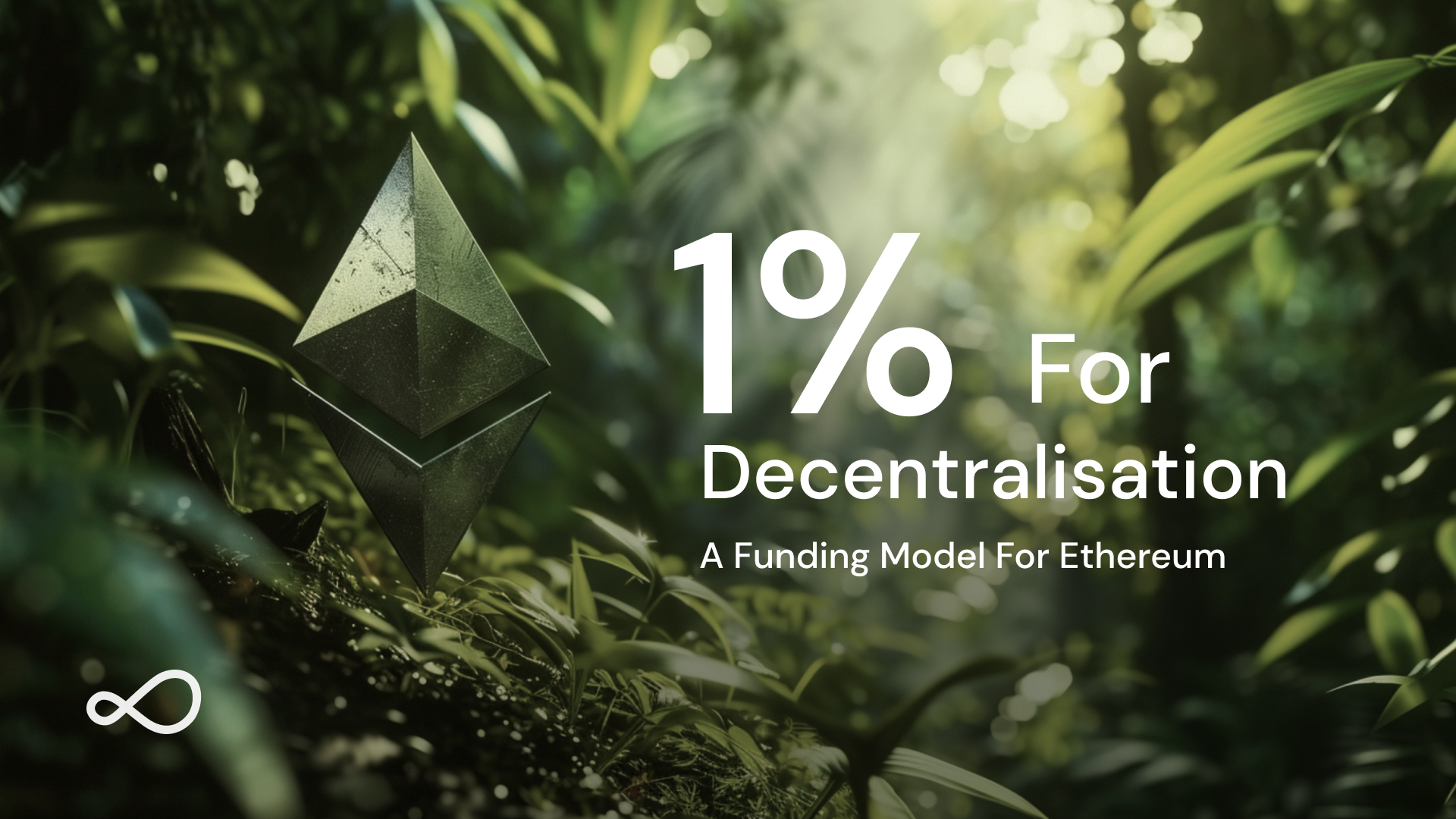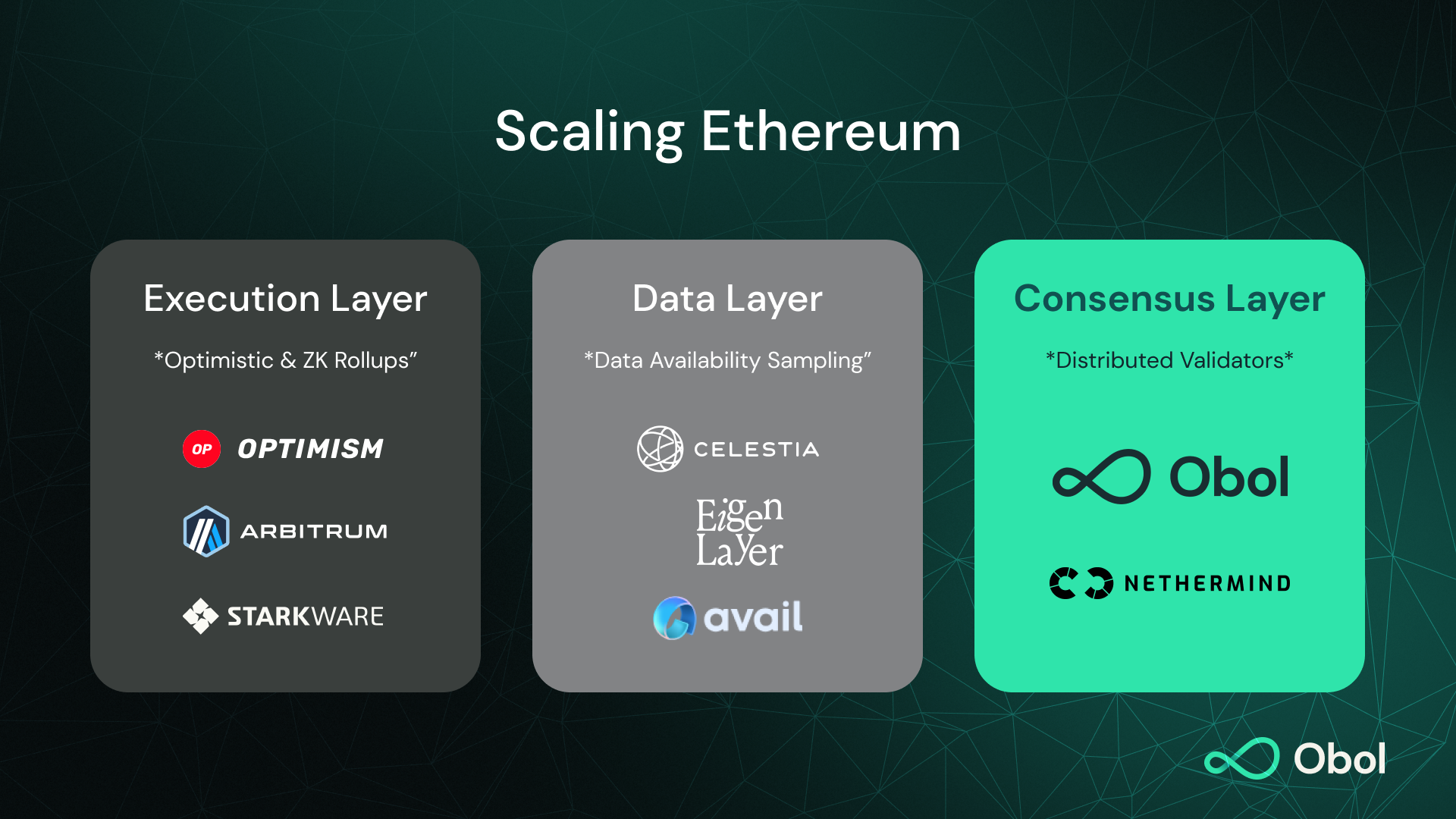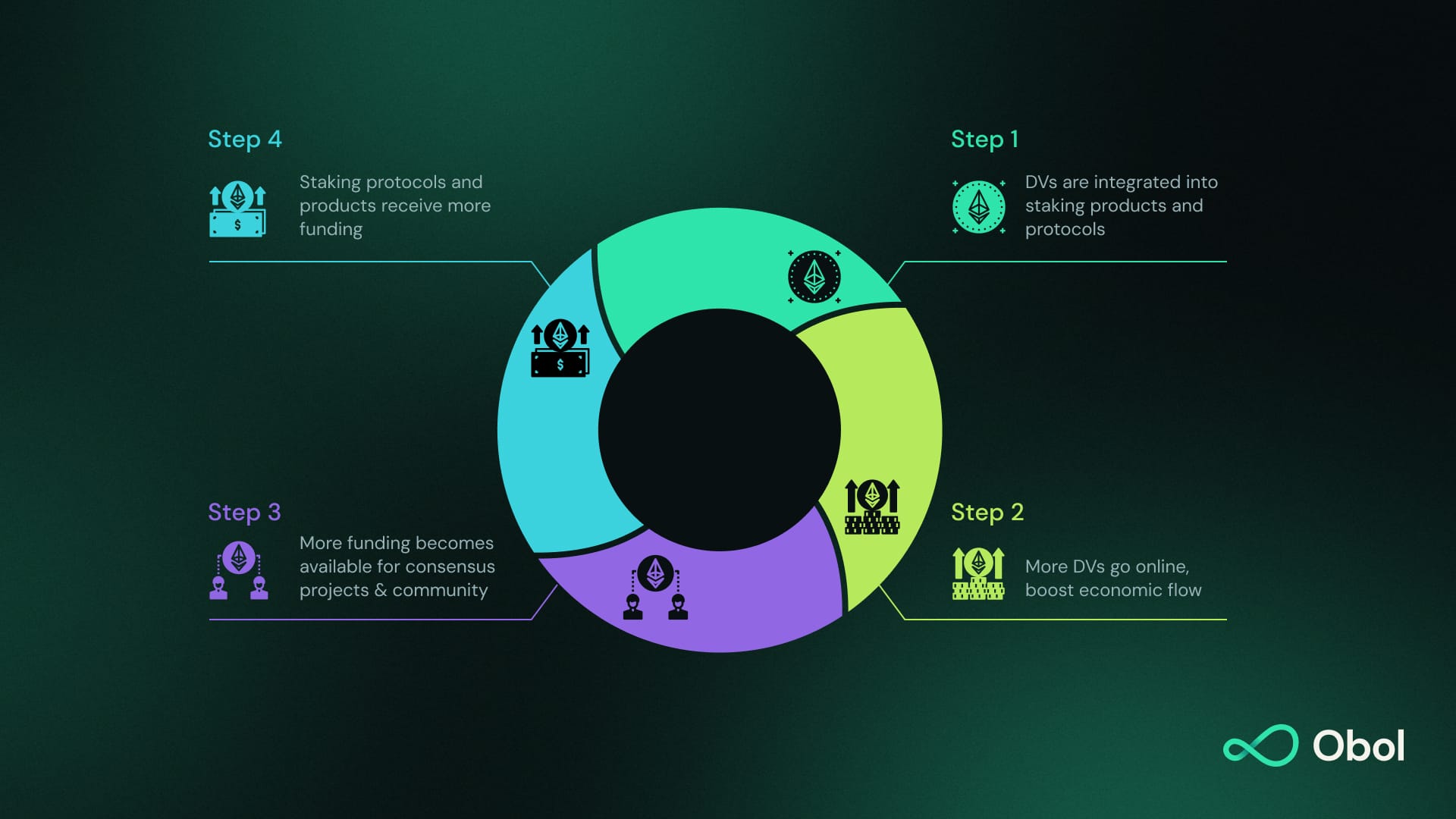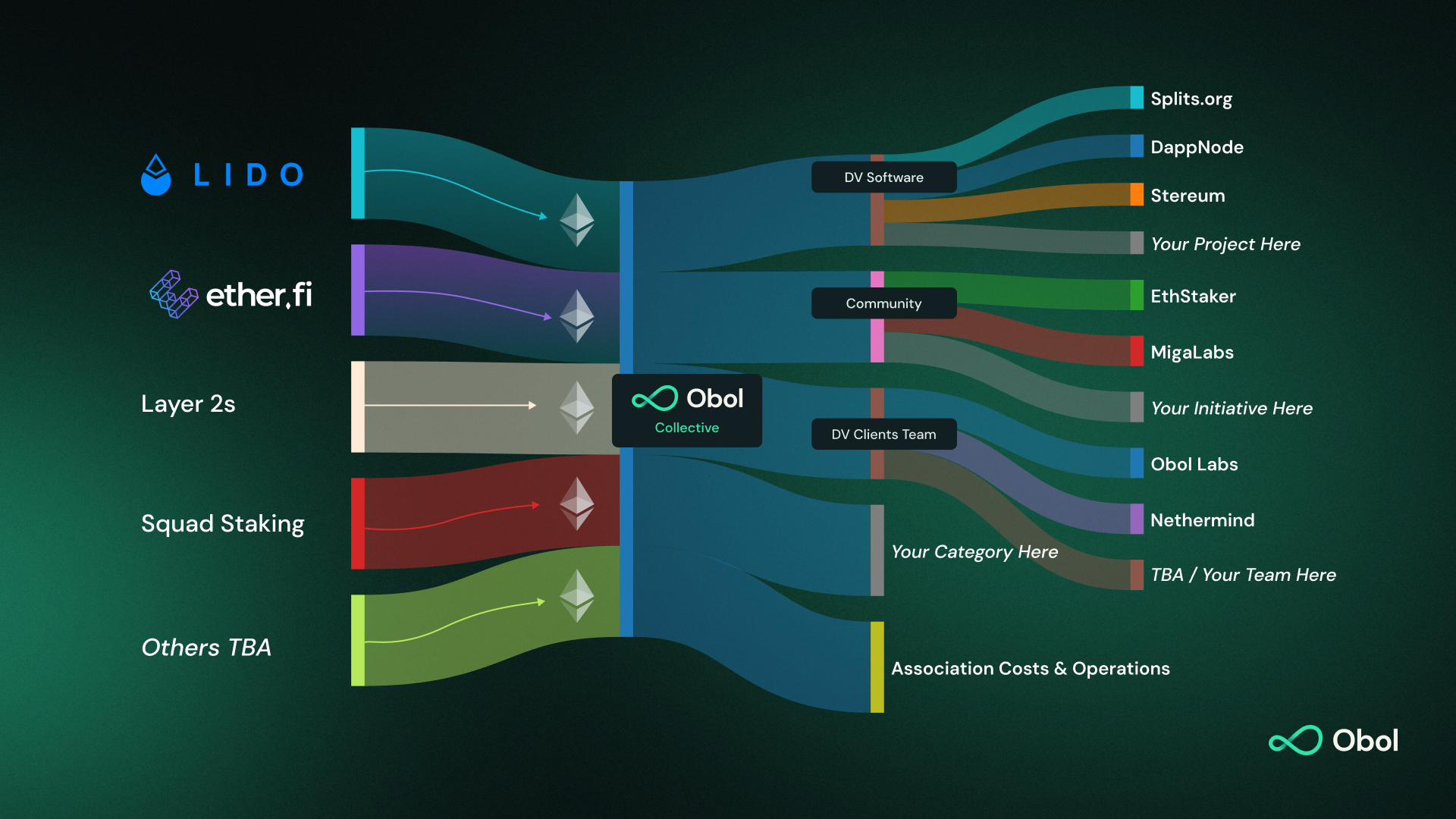1% For Decentralisation: A Funding Model For Ethereum
It’s time for Ethereum staking projects to commit to strengthening Ethereum’s foundation - the consensus layer. This is how Obol is going to help.

TL;DR Obol has launched a funding model to strengthen and promote decentralisation of Ethereum's consensus. Users of Obol distributed validator (DV) clusters will contribute 1% of their staking rewards to a retroactive funding pool. These funds will reward projects and innovations which add value and drive impact towards Ethereum’s decentralisation.
1% for the Planet: 1% for Ethereum Consensus
In the early 2000s, Craig Mathews, the founder of Blue Ribbon Flies, and Yvon Chouinard, the founder of Patagonia, created a retroactive public goods fund (RPGF) for the planet, realising that businesses profiting from the Earth’s resources should also take responsibility for protecting the Earth. From that idea came the 1% for the Planet network, which quickly gathered support from organisations around the world, eventually certifying over $600M USD in donations for environmental causes.
For Ethereum-based projects, Ethereum consensus is like Mother Earth: it is the foundational base of trust for all of the innovation happening today in our $350B+ Ethereum ecosystem. The consensus layer is where the network agrees on the current state of the blockchain through the use of a consensus mechanism, which makes the security and decentralisation of this critical. Just like businesses taking responsibility for protecting the planet which they harvest resources from, it’s time for Ethereum staking projects to commit to strengthening Ethereum’s foundation - the consensus layer.
Making Ethereum Secure, Resilient, and Decentralised
A precedent for application layer funding
Current sources of retroactive funding primarily serve the application layer of the Ethereum network, focusing on “faster, cheaper” Layer 2 (L2) scalability solutions and new demand-driving applications scaling the network to billions of users. The success of funding at the application layer has led to an explosion of new projects and innovation happening in L2 as well as other applications like liquid staking and restaking. While these heroic efforts have paved the way for our mission's reality, new projects at the application layer also make securing and decentralising the consensus layer more important than ever. The Ethereum network requires similar efforts and funding to scale the consensus layer.

Funding for the consensus layer
For Ethereum to achieve its mission, it requires secure, resilient, and decentralised consensus. This is why we created Obol: to ensure that Ethereum consensus has the software and community in place to remain credibly-neutral and trust-minimised.
Today, we’d like to share our model for facilitating a retroactive funding model for strengthening and decentralising Ethereum consensus. With the development of Obol’s funding model, the Ethereum community will receive sustainable funding not only from the application layer but also from the consensus layer of the network - the dawn of a new era.
Growing the ecosystem
Maintaining a distributed validator (DV) ecosystem requires more than just technology: it requires a sustainable source of funding paired with forward-thinking distribution mechanisms to fuel innovation. As the ecosystem grows, network effects will drive further value and increase monetary flows to Obol and the Ethereum ecosystem as a whole. The positive flywheel will accelerate a thriving ecosystem of teams and projects collaborating together to strengthen the Ethereum consensus layer.

The Lessons of History - Retroactive Funding on Ethereum
Early proposals to direct block rewards
In the early days, the community realised that Ethereum lacked a mechanism to reward the researchers and developers who were developing and maintaining the platform. In 2019, EIP-1890 was proposed by Kevin Owocki from Gitcoin, Greg Markou from Chainsafe, and Lane Rettig from the Ethereum Foundation. The idea was to provide sustainable ecosystem funding by directing a portion of each block reward to a developer fund at the Ethereum protocol level. However, it was determined that directing funds from the L1 Ethereum protocol itself would put Ethereum’s neutrality into question, and the EIP was not implemented (The more recent EIP-2025 had a similar fate).
Directing L2 sequencer fees
While capturing and distributing rewards directly from the Ethereum protocol puts its credible neutrality into question, that’s not the case for rewards generated on other layers of the Ethereum stack, like Layer 2’s. Optimism’s RetroPGF program, originally based on a 2021 design introduced by Vitalik, distributed a share of revenue from Optimism’s Layer 2 sequencer. The program supported many young projects which became hugely important to the Ethereum ecosystem: to-date it’s awarded funding to 250+ projects, with the recent third round pledging 30M OP tokens (>$100m). Optimism’s counterpart Arbitrum is likewise busy putting their treasury to work, currently in the third phase of the Arbitrum Foundation Grant Program. Retroactive funding programs like these have built a thriving ecosystem of projects which drive innovation and deliver value to Layer 2 and broader Ethereum scalability efforts - it’s time to do the same for the Ethereum consensus layer.
1% for Decentralisation
Gathering funding via 1% of staking rewards
Just like 1% for the Planet, the idea of a 1% pledge exists in the Ethereum ecosystem too: The Protocol Guild, which collects and distributes donations to Ethereum’s core developers, recently began a “1% pledge” program which encourages projects to pledge 1% of their native tokens toward the development of the Ethereum protocol which they depend on. But projects don’t need a token to fund models like these: although Optimism now has their native OP token, originally they used revenue from their L2 sequencer to fuel their goods funding model. Why not do the same with validators?
A similar model can be replicated for L1 consensus. Obol is launching this funding model to strengthen and promote decentralisation of Ethereum consensus: Users of Obol DV clusters will contribute 1% of their staking rewards to Obol, which will then be used to reward projects and innovations which add value and drive impact at the Ethereum consensus layer.
The first funding contributors
The first contributor toward this model is Lido, via their SimpleDVT module which recently went live on Mainnet - Lido is using Obol DVs to onboard community operators and vastly expand their node operator set. Soon, stake from EtherFi running on DVs will provide an additional source of funding. (As it happens, EtherFi was also the first project to commit to the Protocol Guild’s 1% pledge.)
“Obol's 1% for Decentralisation initiative is a fantastic approach to strengthening the resilience and decentralisation of the Ethereum protocol. By improving the economic sustainability of technologies and research adjacent to DVT, the vision for a more accessible and resilient validator set can be ensured. Lido DAO contributors are excited to witness the further evolution of DVT adoption first hand and help support innovative teams contributing to this mission via Obol validators run via the Simple DVT Module.” - Will Shannon, Lido Contributor, NOM workstream
Distributing funds to decentralisation-oriented projects
Obol aims to support anyone who is adding value and making an impact on the decentralisation of the Ethereum consensus layer. It takes a village. We need technology partners, researchers, educators, ambassadors, community contributors, staking protocols, and of course node operators to be part of the movement to strengthen Ethereum.
“At Nethermind Research, we consider Obol's 1% for Decentralisation to be an important step towards the long-term security and resilience of the Ethereum network. We're excited to see Sedge - our open-source Ethereum full node deployment tool - play a role in this initiative by making it easier for developers to set up and manage validator nodes that use DVT.” - Michał Zając, Head of Research at Nethermind Research
We aim to roll out an initial trial retroactive funding round this year, focused on projects which have provided value within the distributed validator space. At this early stage, it is essential that DVs be made accessible to a broad range of users with different needs, implementations, and skill levels. An especially impactful category of projects are distributed validator “launchers”, tools and products such as DappNode, Stereum, Sedge, and Splits.org which assist users with the creation and management of DVs. Other important efforts include education, research, testing, and community support, provided by projects like EthStaker, Protocol Guild, MigaLabs, and DV Stakers.

These are just some examples of impactful projects which come to mind - as we increase the amount of distributed validators on Mainnet and refine and grow our ability to run retroactive funding distributions, grant rounds will be expanded to cover a large swath of the ecosystem that improves Ethereum’s decentralisation.
This is Just The Beginning
Building out governance
This is just the start. There are many details to be figured out and this model will need refinement and iteration. Over the coming months and years, Obol aims to become a more open, community-governed, and self-sustaining project. The goal is to provide individuals and projects support for their contribution to strengthening Ethereum consensus, no matter the type or size of their contribution.
To perform the collection of applications, voting, and distribution of funds, we’re experimenting with tooling and building out the required infrastructure. We will use the EasyRPG tool developed by the Gitcoin team, itself a public good developed after Optimism’s Round 3, which can be used by projects to build their own retroactive funding rounds.
“Retroactive Public Goods Funding is an important mechanism for ensuring that public goods are well financed and maintained. We’re happy Obol will use EasyRetroPGF and we support Obol’s mission to develop a sustainable funding model for Ethereum.” - Kevin Owocki, GitCoin co-founder
The future is green
Obol will soon begin to support a rich ecosystem of staking applications, as part of our mission to ensure Ethereum’s credible-neutrality and trust-minimisation. Together we will build, integrate, and incentivize projects looking to develop an ecosystem around distributed validators and make Ethereum a more secure and resilient foundation for decades to come.
If you’re looking to get involved, you can already do so by staking with DVs using protocols like Lido or EtherFi, or squad stake via our Launchpad. Join our discord to learn more! We will seek to reward those that support decentralisation. More to come!